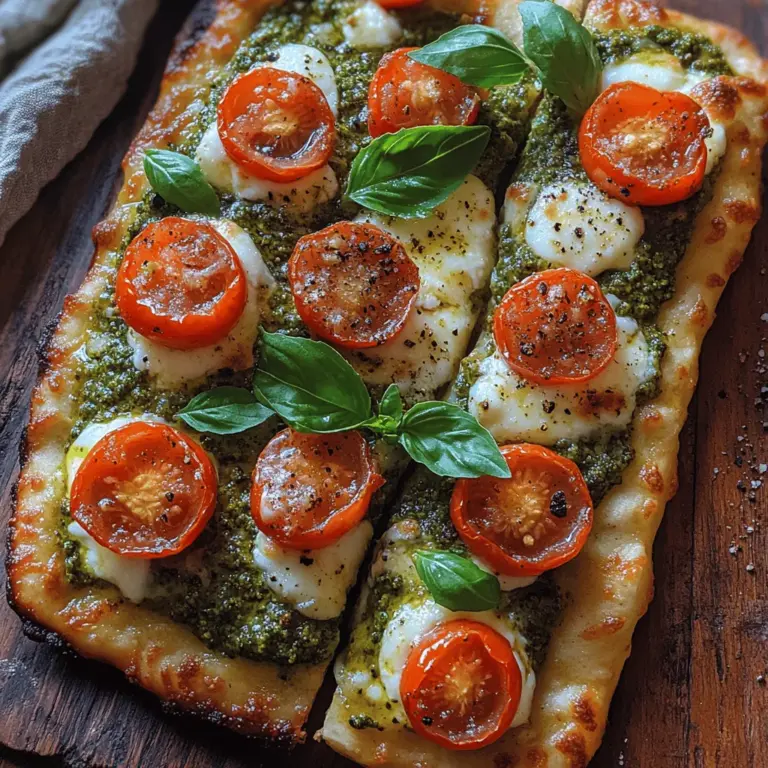Introduction
Welcome to the world of Classic Italian Pesto Flatbread, a dish that’s not just a meal but a celebration of flavors and textures. Originating from the sun-kissed hills of Italy, this flatbread captures the essence of traditional Italian cooking, marrying the robust flavors of fresh basil pesto with a crispy, warm flatbread base. This recipe is significant, as it reflects the Italian philosophy of using high-quality, fresh ingredients to create simple yet delightful dishes that bring people together around the table.
The appeal of Classic Italian Pesto Flatbread lies in its versatility. It can serve as a delectable appetizer, a satisfying main course, or even a delightful side dish. The primary ingredients—fresh basil, garlic, Parmesan cheese, olive oil, and pine nuts—combine to create a vibrant pesto that’s both aromatic and rich. When spread over a warm flatbread, this pesto transforms into a canvas that can be adorned with various toppings, whether you prefer a sprinkle of mozzarella cheese, sliced tomatoes, or even grilled vegetables.
This recipe is perfect for a wide range of audiences. Families looking for a quick and delicious meal, beginners eager to explore their culinary skills, and health-conscious individuals searching for nutritious options will all find joy in crafting their own Classic Italian Pesto Flatbread. Not only is it easy to prepare, but it also allows for creativity in customization, making it a delightful cooking experience for all.
Understanding the Ingredients
To create the perfect Classic Italian Pesto Flatbread, it’s essential to understand the ingredients that make this dish shine. Each component plays a vital role in achieving the desired flavor profile and texture.
Overview of Main Ingredients
1. Fresh Basil: The star of the show, fresh basil is what gives pesto its signature flavor. Look for vibrant green leaves that are free from browning or wilting. Using fresh basil ensures that your pesto is aromatic and flavorful.
2. Garlic: Adding a robust depth of flavor, garlic is a key ingredient in pesto. Choose firm, plump cloves, as they will impart the best taste. For those who prefer a milder flavor, roasted garlic can be used as a substitute.
3. Parmesan Cheese: This hard cheese adds a savory, umami flavor to the pesto. Look for freshly grated or shaved Parmesan for the best results, as pre-packaged options may not offer the same depth of flavor.
4. Pine Nuts: These nuts contribute a rich, buttery texture to the pesto. When toasting them, be careful not to burn them, as they can turn bitter. Alternatively, walnuts or almonds can be used for a different flavor profile.
5. Olive Oil: A high-quality extra virgin olive oil not only binds the ingredients together but also enhances the overall flavor of the pesto. It’s worth investing in a good bottle for this recipe.
6. Flatbread Base: You can either make your own flatbread from scratch or purchase pre-made options. Homemade flatbread allows for a more personalized touch and can be customized with herbs or spices for added flavor.
Protein Source
While Classic Italian Pesto Flatbread can stand alone as a vegetarian dish, adding a protein source can turn it into a more substantial meal. Options include:
– Chicken: Grilled or roasted chicken adds a savory element that pairs well with the pesto.
– Tofu: For a plant-based alternative, marinated and grilled tofu can provide a hearty protein source.
– Beans: Chickpeas or white beans can be added for a protein boost, making the dish both delicious and nutritious.
Vegetables
Incorporating vegetables into your flatbread not only enhances the flavor but also adds essential nutrients. Consider using:
– Bell Peppers: Sweet and colorful, they add crunch and visual appeal.
– Carrots: Shredded or sliced, carrots provide a slight sweetness.
– Broccoli: Steamed or roasted, broccoli adds a hearty texture and a wealth of vitamins.
Grains or Starches
The flatbread itself serves as the starch in this dish. However, if you’re looking to serve it alongside other grains, consider:
– Rice: A side of aromatic herb-infused rice can complement the flavors of the flatbread.
– Quinoa: This protein-packed grain can be served as a bed for the flatbread or on the side.
– Pasta: A light pasta salad can act as a refreshing accompaniment.
Herbs and Spices
In addition to the main ingredients, herbs and spices can elevate your Classic Italian Pesto Flatbread. Consider adding:
– Oregano: A sprinkle of dried oregano can enhance the Italian flavor profile.
– Crushed Red Pepper Flakes: For those who enjoy a kick of heat, a few flakes can add depth.
– Black Pepper: Freshly cracked black pepper can brighten the dish and enhance its overall flavor.
Importance of Fresh, High-Quality Ingredients
The quality of ingredients is paramount when it comes to Italian cooking. Fresh, high-quality ingredients lead to better flavor and nutritional value. When shopping for your ingredients, seek out local markets or organic produce sections to ensure you’re getting the best options. The freshness of your basil, the quality of your olive oil, and the flavor of your cheese will all contribute to the success of your Classic Italian Pesto Flatbread.
Tips for Selecting Ingredients
– Basil: Choose basil with vibrant green leaves and a fragrant smell. Avoid any that are wilting or turning brown.
– Garlic: Select firm garlic bulbs with no signs of sprouting or soft spots.
– Cheese: Look for cheese that is freshly grated or in block form. Pre-grated cheese often contains anti-caking agents that can affect the flavor.
– Pine Nuts: Check for freshness by smelling them; they should have a nutty aroma. If they smell rancid, they are past their prime.
– Flatbread: If purchasing, opt for whole grain options for added fiber. If making from scratch, use quality flour for the best texture.
Preparation Steps
Once you have gathered your ingredients, it’s time to prepare for the cooking process. This section will guide you through the necessary steps to ensure a smooth cooking experience.
Prepping the Ingredients
1. Washing and Chopping Vegetables: Start by washing all your vegetables thoroughly under cold running water. For bell peppers, remove the seeds and slice them into thin strips. If using carrots, peel and julienne them for even cooking. For broccoli, break it into small florets.
2. Marinating or Seasoning the Protein: If you’ve chosen to include a protein, now is the time to season it. For chicken, a simple marinade of olive oil, garlic, salt, and pepper works wonders. For tofu, press it to remove excess moisture, then marinate in a mixture of soy sauce and garlic. Allow the protein to soak in the flavors while you prepare the rest of the ingredients.
3. Measuring Out Grains or Starches: If you’re serving your flatbread with a side of grains, measure out the desired amount. For rice, a standard serving is typically half a cup uncooked per person. For quinoa, rinse it under cold water to remove any bitterness before cooking.
Cooking Methods
Understanding various cooking methods will help you achieve the best flavor and texture for your Classic Italian Pesto Flatbread.
1. Sautéing: This quick method is perfect for cooking vegetables. Heat a tablespoon of olive oil in a skillet over medium heat, add the chopped vegetables, and sauté until they are tender yet still crisp. This method retains the vibrant colors and flavors of the veggies.
2. Boiling: If you’re cooking grains like rice or quinoa, follow package instructions for boiling. Adding a pinch of salt to the water enhances the flavor of the grains.
3. Roasting: Roasting vegetables brings out their natural sweetness. Toss them in olive oil and seasonings before spreading them on a baking sheet and roasting at 400°F (200°C) for about 20-25 minutes, or until they are tender and caramelized.
4. Grilling: For protein sources like chicken or tofu, grilling adds a smoky flavor. Preheat your grill and cook until the internal temperature reaches safe levels (165°F for chicken, 145°F for tofu) while ensuring a nice char on the outside.
Tips for Achieving the Best Flavor and Texture
– Don’t rush the marinating process: Allow your protein to marinate for at least 30 minutes to absorb the flavors.
– Use a hot pan for sautéing: This helps to sear the vegetables quickly, locking in their moisture and flavor.
– Monitor cooking times: Overcooking can lead to mushy vegetables or dry protein, so keep a close eye on the cooking process.
– Taste as you go: Adjust seasonings and flavors throughout the cooking process to achieve the perfect balance.
In the next section, we will delve into the step-by-step recipe instructions for crafting your Classic Italian Pesto Flatbread, ensuring that you have all the guidance necessary to create this delightful dish.
{{image_2}}
Visual Cues for Doneness and Flavor Development
When making your Classic Italian Pesto Flatbread, it’s essential to recognize the signs of doneness and flavor development. As the flatbread bakes, you should look for a golden-brown color on the crust, which indicates that it’s crisp and ready to be taken out of the oven. The edges should be slightly darker, while the center remains firm but not hard.
Another key indicator is the aroma that fills your kitchen. As the flatbread bakes, the smell of fresh pesto, toasted garlic, and melted cheese will waft through your home, signaling that the flavors are melding beautifully. Once removed from the oven, allow it to cool for a few minutes before slicing, as this resting period helps enhance the flavor and texture.
Flavor Enhancements
Suggested Additions for Flavor
While the classic pesto flatbread recipe is delightful on its own, you can elevate the flavor profile by adding a few additional ingredients. Consider incorporating sun-dried tomatoes for a tangy sweetness or roasted red peppers for a smoky flavor. Fresh mozzarella can be swapped for burrata to add a creamy richness, while a sprinkle of red pepper flakes can introduce a delightful kick.
Sauces or Dressings that Complement the Dish
To enhance your Classic Italian Pesto Flatbread, pair it with complementary sauces or dressings. A drizzle of balsamic reduction adds a sweet tanginess that balances the savory notes of the pesto. Alternatively, a simple garlic aioli can bring a creamy texture and depth of flavor. For those who enjoy a zesty twist, a squeeze of fresh lemon juice or a light citrus vinaigrette can brighten the dish, making it even more enjoyable.
Optional Garnishes
Garnishing your flatbread can elevate its presentation and flavor. Fresh herbs, such as basil or parsley, add a pop of color and freshness. Pine nuts or walnuts can be toasted and sprinkled on top for added crunch and nuttiness. A light dusting of grated Parmesan cheese not only enhances the visual appeal but also enriches the flavor profile.
Adjusting for Different Dietary Preferences
One of the great aspects of this pesto flatbread recipe is its versatility. If you’re catering to specific dietary needs, there are several adjustments you can make:
– Vegan or Vegetarian Alternatives: For a vegan option, ensure you use plant-based cheese or omit the cheese altogether. You can also enhance the flavor by adding more vegetables, like spinach or arugula, which pair wonderfully with pesto.
– Gluten-Free Options: For gluten-free eaters, substitute traditional flour with gluten-free flour blends or use store-bought gluten-free flatbread. This allows everyone to enjoy the recipe without compromising on taste.
Serving Suggestions
Ideas for Plating and Presentation
Presentation plays a significant role in how we enjoy food. For your Classic Italian Pesto Flatbread, consider serving it on a rustic wooden board or a vibrant platter. Cut the flatbread into bite-sized pieces or wedges for easy sharing. A scattering of fresh herbs or microgreens on top adds a beautiful touch. For a more sophisticated presentation, you can serve it alongside a small bowl of extra pesto or a dipping sauce.
Recommended Side Dishes or Beverages that Pair Well
To create a well-rounded meal, pair your flatbread with complementary side dishes. A mixed green salad with a light vinaigrette can provide a refreshing contrast to the richness of the flatbread. Grilled vegetables or a charcuterie board featuring Italian cheeses and cured meats make excellent accompaniments.
In terms of beverages, a crisp white wine, such as Pinot Grigio or a light-bodied red like Chianti, pairs wonderfully with the flavors of the dish. For a non-alcoholic option, consider sparkling water with a slice of lemon or a homemade lemonade with fresh herbs.
How to Store Leftovers and Reheat Properly
If you have leftovers, store the flatbread in an airtight container in the refrigerator for up to three days. To reheat, preheat your oven to 350°F (175°C) and place the flatbread directly on the oven rack for about 5-10 minutes, or until warmed through. This method helps restore its crispiness. Alternatively, you can use a microwave, but be aware that this method may result in a softer crust.
Nutritional Benefits
Breakdown of Nutritional Content per Serving
A serving of Classic Italian Pesto Flatbread typically contains the following nutritional content, although this can vary based on specific ingredients used:
– Calories: Approximately 250-300
– Protein: 8-10 grams
– Carbohydrates: 30-35 grams
– Dietary Fiber: 2-3 grams
– Fat: 10-15 grams
These values can fluctuate based on the toppings and portion sizes, so keep this in mind when preparing your meal.
Health Benefits of Key Ingredients
The key ingredients in pesto and flatbread offer several health benefits:
– Basil: Rich in antioxidants and has anti-inflammatory properties, contributing to overall wellness.
– Olive Oil: A staple in Mediterranean diets, olive oil is known for its heart-healthy fats and anti-inflammatory effects.
– Nuts: Pine nuts or walnuts in pesto provide healthy fats, protein, and essential vitamins and minerals.
– Whole Grains: If using whole wheat flour for the flatbread, you’ll benefit from additional fiber and nutrients compared to white flour.
Importance of a Balanced Meal
Enjoying a Classic Italian Pesto Flatbread can be part of a balanced meal when paired with vegetables and lean proteins. Incorporating a variety of food groups ensures that you receive essential nutrients while indulging in delicious flavors.
Cultural Significance
Historical Background of the Dish
Pesto is a traditional Italian sauce that originates from the Liguria region, specifically from the city of Genoa. The name “pesto” comes from the Italian word “pestare,” meaning to crush or pound, which refers to the original method of preparation with a mortar and pestle. The classic combination of basil, pine nuts, garlic, Parmesan cheese, and olive oil creates a rich and aromatic sauce that has become a staple in Italian cuisine.
The concept of flatbreads is also deeply rooted in various cultures around the world. Flatbreads have been enjoyed for centuries, with each region adding its own twist. The combination of pesto with flatbread represents a fusion of traditional Italian flavors with a versatile bread that is enjoyed globally.
Variations Across Different Cultures or Regions
While the Classic Italian Pesto Flatbread is a delightful dish, variations exist across different cultures. For example, in Middle Eastern cuisine, flatbreads like pita are often paired with herbaceous dips like za’atar or tahini. In India, naan flatbreads might be enjoyed with spicy chutneys or yogurt. Each culture brings its unique ingredients and preparation methods, showcasing the universality of flatbreads as a beloved food.
Personal Anecdotes or Stories Related to the Dish
Many home cooks have fond memories associated with making flatbread with family members, often passed down through generations. Whether gathering around the kitchen to prepare the dough or sharing a meal together, these moments create lasting bonds. The versatility of flatbread allows for creativity, making it an excellent canvas for experimenting with flavors and ingredients.
Conclusion
In summary, the Classic Italian Pesto Flatbread is not just a dish; it’s a celebration of flavors, culture, and creativity in the kitchen. With its rich, aromatic pesto and crispy crust, it brings joy to any table. The recipe’s adaptability ensures that everyone can enjoy it, regardless of dietary preferences.
Cooking and sharing meals with loved ones fosters connection and happiness. We encourage you to make this recipe your own by experimenting with various toppings and flavors. Whether you’re hosting a dinner party or enjoying a quiet meal at home, this flatbread is sure to impress. So gather your ingredients, unleash your creativity, and savor the delightful experience of creating and sharing your Classic Italian Pesto Flatbread.


